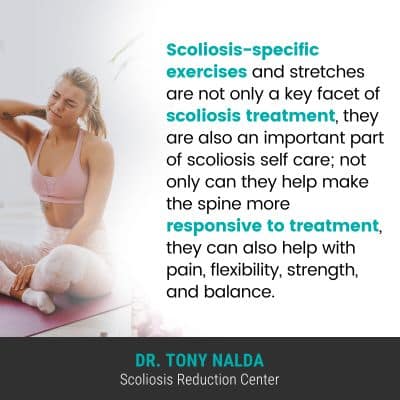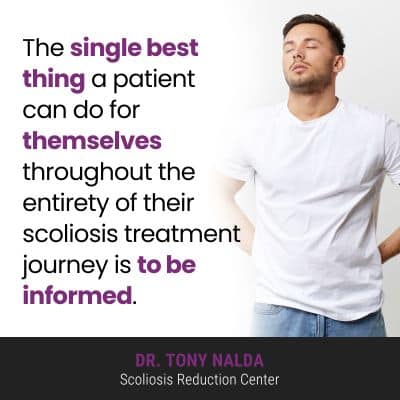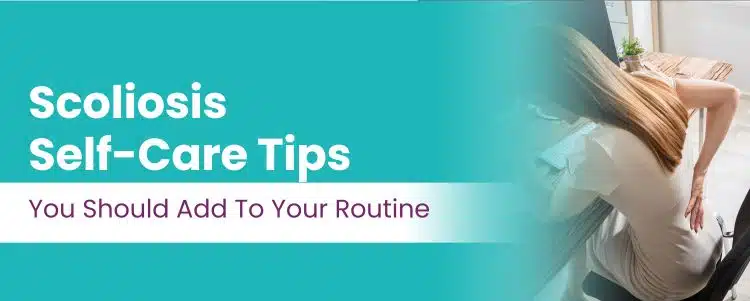Self-care can mean different things to different people, but involves being kind to oneself in an effort to preserve physical and mental health. Self-care can mean knowing when to take a break, saying no to demands, and managing time effectively to find a balance between work and play. For scoliosis patients, understanding the importance of self-care is important.
When it comes to living with scoliosis, there are challenges that are both overt and subtle. People with scoliosis have to practice self-care to handle the rigors of living with, and treating, scoliosis, including daily stretching and exercise.
Self-care is particularly important for those living with additional challenges associated with scoliosis, so before getting to specific self-care tips, let’s start with the effects of scoliosis.
Scoliosis Effects
Scoliosis is the development of an unnatural sideways-bending and rotating spinal curve, and as a progressive condition, its nature is to get worse over time.
As scoliosis progresses, the curve size is increasing, as are the condition’s uneven forces, and their effects.
Scoliosis effects range from person to person based on a number of key patient/condition variables: patient age, condition type, severity, and curvature location.
The more severe the condition, the more likely it is that its effects are going to be noticeable, and the more a condition progresses, the more complex it is to treat.
When it comes to the main scoliosis effects, patient age is an important factor, so I like to divide the topic of scoliosis effects into two categories: childhood scoliosis and adult scoliosis.
Postural Changes
When it comes to the main effect of scoliosis in children, we’re talking about postural deviation caused by the condition’s uneven forces, and as they disrupt the body’s overall symmetry, postural changes, and postural awareness are important.
The main type of scoliosis to affect both children and adults is idiopathic scoliosis, and the most prevalent type of scoliosis overall is adolescent idiopathic scoliosis, diagnosed between the ages of 10 and 18.
In children, the main effect is postural deviation, and oftentimes, it’s uneven shoulders and hips that are the condition’s earliest telltale signs.
Additional postural changes can include:
- The head not being centered over the torso
- An uneven eye line
- Uneven shoulder blades
- The development of a rib cage arch
- An uneven waist line
- Arms and legs that hang at different lengths
Additional changes can include disruptions to balance, coordination, and gait, and as a progressive condition, the nature of scoliosis is to get worse over time, hence the importance of proactive treatment, and part of scoliosis self-care involves recognizing the seriousness of the condition, understanding its need for treatment, and how to lead a spine-friendly lifestyle.
Pain
When it comes to the main effect of scoliosis in adults, we’re talking about pain.
Scoliosis doesn’t become a compressive condition until skeletal maturity has been reached, so in children who are still growing, scoliosis isn’t commonly described as painful; although growth is the trigger for progression, so children are more at risk for rapid-phase progression than adults.
When a spine is growing, as it is during childhood, and particularly puberty, the constant lengthening motion can counteract the compressive force of the unnatural spinal curve, and it’s compression of the spine and its surrounding muscles and nerves that causes the majority of condition-related pain.
So a lot of scoliosis self-care, particularly for adults, also focuses on how to reduce pain for a good quality of life.
So what types of things can a person do to minimize the condition’s effects through self-care?
Exercise and Stretching for Spinal Strength and Flexibility

Scoliosis introduces a lot of uneven forces to the spine, its surrounding muscles and nerves, and the entire body; adverse spinal tension makes the spine weaker and more vulnerable to injury, progression makes the spine increasingly rigid, and scoliosis can also cause a number of effects, including a muscle imbalance.
Scoliosis-specific exercises and stretches are not only a key facet of scoliosis treatment, they are also an important part of scoliosis self care; not only can they help make the spine more responsive to treatment, they can also help with pain, flexibility, strength, and balance.
Scoliosis-specific exercises and stretches can help reduce pain by maintaining spinal strength and flexibility, and they can also provide core strengthening and promote good posture.
A spine that’s more flexible is one that can move easily and enjoy a wide range of activities, and a strong core means a spine that’s supported and stabilized by its surrounding muscles, and this can help counteract the effects of balance and coordination disruptions.
Certain yoga positions can also be ideal for cultivating a self-care routine as starting the day with stretching can have therapeutic benefits.
In addition, one of the effects of scoliosis can be a muscle imbalance as the abnormal spinal curvature pulls the spine’s surrounding muscles in different directions as they struggle to support it, particularly as the condition is progressing, certain exercises can be designed to target muscle symmetry.
Increasing spinal flexibility makes it more responsive to treatment, and a wide range of motion means being able to participate in a number of sports, exercises, and activities, not to mention the endorphin-boosting effect of exercise and the benefits for mental health.
So a positive facet of scoliosis self-are to be included in daily routines should include regular stretching and exercises that are specifically designed to benefit a scoliotic spine.
Safeguarding Mental Health and Well Being
Mental health professionals can help guide patients on their scoliosis journey, particularly children and adolescents for whom postural changes can be stressful and overwhelming; most adolescents don’t want to look different, they don’t want to walk differently, or become unbalanced, and the pressure of having the perfect body can take its toll, particularly in the age of social media.
Safeguarding mental health means that patients recently diagnosed have a support system, have people they can talk to, and when it comes to childhood scoliosis, this means talking to parents and/or caregivers about difficult thoughts and feelings.
Imagine the stress a young adolescent football star would have when a routine physical leads to a diagnosis of scoliosis. Football and contact sports aren’t deemed safe in many cases of scoliosis; this can be life-altering news.
Reducing stress through talking, sharing of experiences, support, and empowerment through information is key.
There are different treatment options available for patients to choose between, and fully understanding the pros and cons of each is the ultimate act of self-care because the result can shape long-term spinal health and function: factors that can, in turn, shape quality of life.
I like to point out to adolescents recently diagnosed that although scoliosis is progressive and incurable, it can be highly treatable, and there are a number of professional athletes and celebrities whose success, despite having scoliosis, proves that a scoliosis diagnosis doesn’t have to mean a life of limitations.
Proactive Treatment as Self Care

The single best thing a patient can do for themselves throughout the entirety of their scoliosis treatment journey is to be informed.
Scoliosis is a highly-prevalent spinal condition that’s often misunderstood.
The most important thing for patients to understand is that a watch-and-wait approach can mean merely observing conditions while they progress unimpeded, and only responding with treatment once a certain severity level is reached; this is wasting valuable treatment time.
A modern conservative treatment approach treats the whole patient and addresses the condition proactively, and part of my treatment here at the Scoliosis Reduction Center® involves lifestyle guidance; I want to help patients cultivate a healthy spine-friendly lifestyle that highlights the importance of self-care.
For those experiencing scoliosis-related pain, a variety of therapies can be recommended, and for those in need of strengthening, scoliosis exercises and stretches, designed by a scoliosis specialist, can help minimize scoliosis symptoms, help with pain relief, improve bone health, and improve mental well-being.
Conclusion
Self-care will mean different things to different people with scoliosis.
Condition severity and patient age are important factors when it comes to shaping a patient’s overall quality of life with the condition.
When it comes to the power of exercise and stretching, this can help with treatment, spinal strength and flexibility, balance, minimizing the condition’s effects, postural awareness, and mental health benefits.
Improving core stability means a spine that’s receiving optimal support and stabilization and one that’s less likely to develop a muscle imbalance.
Self-care can also mean being informed, knowing the types of questions to ask prospective treatment providers, and understanding all the treatment options available to ensure proactive treatment is applied as close to the time for diagnosis as possible when the condition is likely to be its most responsive.
Also understanding the importance of bone health, vitamin D, and the benefits of anti-inflammatory foods can be part of leading a spine-friendly lifestyle.
Self-care also means knowing which activities are deemed safe for people with scoliosis, which should be approached with caution, and which should be avoided; while these recommendations are always case-specific, in general, collision sports and/or activities with repeated shocks, like football and horseback riding, should be avoided.
Scoliosis self-care is about awareness: awareness of the power of exercises specifically for scoliosis, awareness of how the condition can affect mental well-being, and understanding the importance of a proactive treatment plan.
When it comes to cultivating a daily self-care routine with scoliosis, each patient will have their own needs and strategies, but in general, daily stretching, exercise, and treatment are the keystones.




